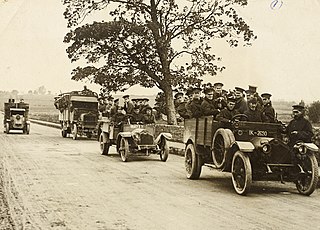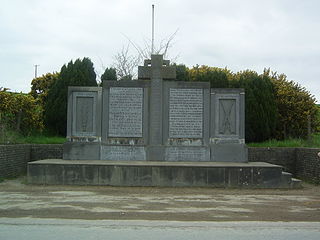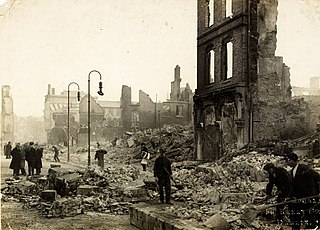The Carrowkennedy ambush was an ambush carried out by the Irish Republican Army (IRA) on 2 June 1921, during the Irish War of Independence. An IRA flying column, commanded by Michael Kilroy, ambushed a mobile patrol of the Royal Irish Constabulary including Black and Tans recruits at Carrowkennedy, near Westport, County Mayo. It resulted in the deaths of seven of the RIC, including some who were killed by their own rifle grenade. After two hours the RIC surrendered and their weaponry and ammunition were seized by the IRA.

This is a timeline of the Irish War of Independence of 1919–21. The Irish War of Independence was a guerrilla conflict and most of the fighting was conducted on a small scale by the standards of conventional warfare.

Mourne Abbey, or Mourneabbey, is a small civil and Roman Catholic parish in the barony of Barretts, northwest County Cork, Ireland. The parish is situated just south of Mallow, on the main Mallow-Cork Road and Rail Line. The population of the parish is about 1,000 people. There are two churches and schools in the area, Analeentha and Burnfort. The civil parish consists of 17 townlands.

The Crossbarry ambush, also known as the Battle of Crossbarry, occurred on 19 March 1921 and was one of the largest engagements of the Irish War of Independence. It took place near the small village of Crossbarry in County Cork, about 20 km south-west of Cork city. About a hundred Irish Republican Army (IRA) volunteers, commanded by Tom Barry, escaped an attempt by about 1,200 British troops to encircle them. During the hour-long battle, ten British troops and three IRA volunteers were killed.
The Coolavokig ambush was carried out by the Irish Republican Army (IRA) on 25 February 1921, during the Irish War of Independence. It took place at Coolavokig, on the road between Macroom and Ballyvourney, County Cork. A 60-man flying column of the IRA's 1st Cork Brigade under Seán O'Hegarty, ambushed a 70-man convoy of the Auxiliary Division under Major Seafield Grant, sparking a four-hour battle. Ten Auxiliaries were killed, including Major Grant, and others wounded. The IRA column left the area when British reinforcements arrived. After the ambush, British forces stopped carrying out raids and patrols in the area.
The Scramoge ambush was an ambush carried out by the Irish Republican Army (IRA) on 23 March 1921, during the Irish War of Independence. The IRA ambushed a lorry carrying British troops and Royal Irish Constabulary (RIC) officers at Scramoge, near Strokestown in County Roscommon. Three British soldiers and an RIC officer were killed, while two RIC 'Black and Tans' were captured and shot dead shortly after.
The Clonfin Ambush was an ambush carried out by the Irish Republican Army (IRA) on 2 February 1921, during the Irish War of Independence. It took place in the townland of Clonfin between Ballinalee and Granard in County Longford. The IRA ambushed two lorries carrying members of the British Auxiliary Division, sparking a lengthy gun battle in which four Auxiliaries were killed and eight wounded. The Auxiliaries eventually surrendered and their weapons were seized. The IRA commander, Seán Mac Eoin, won some praise for helping the wounded Auxiliaries. Following the ambush, British forces burned a number of houses and farms in the area, and shot dead an elderly farmer.
The Selton Hill ambush took place on 11 March 1921, during the Irish War of Independence. An Irish Republican Army (IRA) flying column was ambushed by members of the RIC Auxiliary Division at Selton Hill, County Leitrim. Six IRA members of the South Leitrim Brigade were killed, which effectively destroyed the IRA in South Leitrim.
The Burgery ambush was an ambush carried out by the Irish Republican Army (IRA) on 18–19 March 1921, during the Irish War of Independence. It took place near Dungarvan, County Waterford.

Michael Kilroy was an Irish republican and politician. He was an Irish Republican Army (IRA) officer in his native County Mayo during the Irish War of Independence and Irish Civil War. Subsequently, he was a Sinn Féin and later Fianna Fáil Teachta Dála (TD) for Mayo South.

The burning of Cork, by British forces, took place during the Irish War of Independence on the night of 11–12 December 1920. It followed an Irish Republican Army (IRA) ambush of a British Auxiliary patrol in the city, which wounded twelve Auxiliaries, one fatally. In retaliation, the Auxiliaries, Black and Tans and British soldiers burned homes near the ambush site, before looting and burning numerous buildings in the centre of Cork, Ireland's third-biggest city. Many Irish civilians reported being beaten, shot at, and robbed by British forces. Firefighters testified that British forces hindered their attempts to tackle the blazes by intimidation, cutting their hoses and shooting at them. Two unarmed IRA volunteers were also shot dead at their home in the north of the city.

The Headford Ambush was carried out by the Irish Republican Army (IRA) on 21 March 1921, during the Irish War of Independence. The IRA's 2nd Kerry Brigade ambushed a train carrying British troops of the Royal Fusiliers at Headford Junction railway station near Killarney, County Kerry. This sparked a battle lasting almost an hour, in which at least 13 people were killed – nine British soldiers, two IRA volunteers and three civilians. The IRA withdrew after another train carrying British troops arrived.
The Tooreen ambush was an ambush carried out by the Irish Republican Army (IRA) on 22 October 1920, during the Irish War of Independence. It took place near Roberts Farm, Tooreen, near Ballinhassig in County Cork. The IRA ambushed two lorries of British soldiers, killing three and wounding four others. The British surrendered and their weapons and ammunition were seized by the IRA. Later that night, British soldiers went on a rampage in nearby Bandon.
The Clonbanin ambush was an ambush carried out by the Irish Republican Army (IRA) on 5 March 1921, during the Irish War of Independence. It took place in the townland of Clonbanin, County Cork.
The Rineen ambush was an ambush carried out by the Mid Clare Brigade of the Irish Republican Army (IRA) on 22 September 1920, during the Irish War of Independence. The attack took place at Drummin Hill in the townland of Drummin, near the hamlet of Rineen, County Clare.
The Pickardstown ambush, an action in the Irish War of Independence, took place near the town of Tramore, County Waterford on the night of 6 January 1921.
The Dromkeen ambush took place on 3 February 1921, during the Irish War of Independence, at Dromkeen in County Limerick. The Irish Republican Army (IRA) ambushed a Royal Irish Constabulary (RIC) patrol, killing 11 policemen.
The Kilmeena ambush was an action during the Irish War of Independence that took place at Kilmeena, County Mayo on 19 May 1921. The ambush ended in defeat for the local West Mayo Irish Republican Army (IRA), with five IRA volunteers killed and four wounded and captured. Two members of the Royal Irish Constabulary (RIC) and one Black and Tan were also killed in the action.
The Tourmakeady ambush or Battle of Tourmakeady occurred on 3 May 1921 during the Irish War of Independence. The South Mayo Brigade of the Irish Republican Army (IRA), commanded by Commandant Tom Maguire ambushed an RIC/Black and Tan re-supply patrol in the village of Tourmakeady, County Mayo in the west of Ireland in order to destroy the patrol and to cause the closure of Derrypark RIC Barracks, seven miles to the south.
The Drumcondra ambush was an attempted ambush carried out the Irish Republican Army (IRA) in Drumcondra, a suburb in northern Dublin, during the Irish War of Independence. On 21 January 1921, an IRA active service unit (ASU) initially set up an ambush near the Royal Canal in preparation for a British lorry which was travelling through the area. When the lorry failed to arrive, Frank Flood, the unit's commander, relocated his men up to a new position along the Tolka river. However, the IRA unit was spotted as they were setting up their new positions and a force of Auxiliaries was sent out, which resulted in 1 volunteer being killed and 5 others being arrested as they were attempting to escape.






